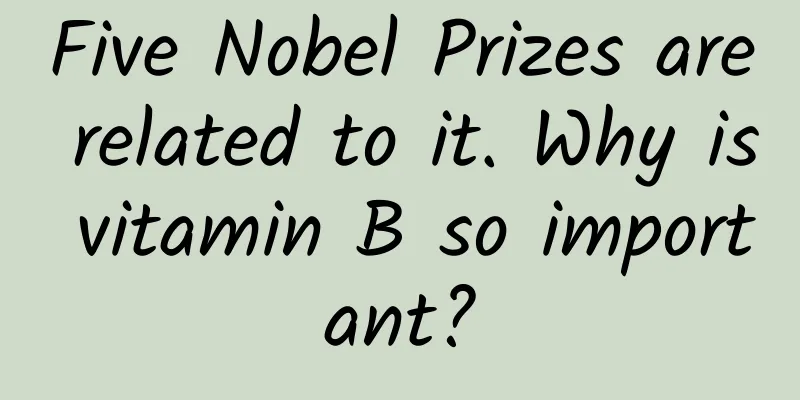Five Nobel Prizes are related to it. Why is vitamin B so important?

|
Tuchong Creative In recent years, vitamins have become very popular. For example, vitamin C can resist oxidation and prevent anemia; vitamin D can not only promote calcium absorption and strengthen bones, but also regulate immunity. On the contrary, when it comes to vitamin B, more people will only think of the small white medicine bottle placed in the corner of the pharmacy. Vitamin B may seem inconspicuous, but it is actually a seriously underestimated "invisible guardian" of health. Why is it so important? Let me tell you a story. During the Edo Shogunate period in Japan, a disease called beriberi spread among the dignitaries, and the famous Emperor Meiji suffered from this disease. Moreover, the impact of this disease was very large. During the Russo-Japanese War alone, it caused the deaths of nearly 30,000 soldiers, almost half of the total number of casualties. The cause of this terrible disease has always been a mystery. Scientists initially inferred that the cause of the disease might be some kind of pathogenic microorganism, until Berlin scientist Eijkman discovered that beriberi might be related to a special nutrient in brown rice. In 1910, Polish chemist Funk successfully separated and extracted this special substance from rice bran and named it vitamin B1. In 1929, Eijkman also won the Nobel Prize in Physiology or Medicine for his contribution to curing beriberi. After understanding how vitamins were discovered, it is necessary for us to re-understand the B vitamins. This water-soluble vitamin is both small and huge. It is small because it is a small molecule compound. It is huge because it is a large family of 8 members, unlike other vitamins which are individual individuals, so it is also called B vitamins. Members include vitamin B1, B2, B3, B5, B6, B7, B9 and B12, each with its own unique name, such as vitamin B1, also known as thiamine, B2, also known as riboflavin, and B3, also known as niacin. Hearing this, two questions will surely pop up in your mind. First, there are 12 types from 1 to 12, why is it just said to be 8 types? Where are vitamins B4, B8, B10 and B11? That’s right, 8. Those missing numbers were actually removed or merged during the research process. Take vitamins B4 and B8 as examples. They originally represented adenine and adenine nucleotide, respectively. Later, it was discovered that they were actually the raw materials for DNA synthesis, so they were excluded from vitamins. Moreover, the initial ranking of B vitamins was not 12, but once ranked B17. Later, it was discovered that they did not belong to the B vitamins and were discarded. The second question is, why are other vitamins individual entities, but vitamin B is a group? There is a story behind this. Two years after the discovery of vitamin B1, vitamin A was discovered. Limited by the technology at the time, scientists believed that there might be two types of vitamins, one fat-soluble and one water-soluble. The fat-soluble ones are all called A, and the water-soluble ones are all called B. So B2, B12, etc. discovered later were directly classified into the water-soluble vitamin B sequence. Later, as more and more vitamins were discovered, scientists realized that the differences between them were too great to be classified so simply, so there were divisions such as vitamin C and vitamin D. Moreover, there are indeed commonalities between members of the B vitamins, such as similar sources, mostly extracted from grains, yeast and animal livers, and certain similarities in function. What powerful functions do B vitamins have? There is a joke on the Internet: other people drink more hot water when they feel unwell, but doctors take some vitamin B. For example, if you have acne on your face, you should take vitamin B, if you have ulcers in your mouth, you should take vitamin B, if you drink too much at social events, you should take vitamin B, if you lose weight, you should take vitamin B, and even if you have morning sickness, you should take vitamin B. This also reflects from the side that B vitamins are involved in all areas of health. In fact, members of the B group are involved in almost all biochemical reactions in the body. For example, vitamin B6 and B12, as coenzymes or coenzyme precursors, participate in the metabolism of sugar, protein and fat in the human body and become the key to releasing energy from food. Without them, the human body will find it difficult to obtain enough energy. In addition, B vitamins also play a role in these places. For example, they are nutrients needed to make blood; participate in maintaining the health of skin and mucous membranes; help body tissues use oxygen; remove toxins such as alcohol and nicotine, and protect liver health; maintain nervous system function, relieve headaches and migraines; relieve stress, eliminate fatigue, and make people energetic; prevent blood vessel occlusion and maintain heart and blood vessel health. Adhering to the concept of "brothers working together can break metal", the eight B vitamin brothers never fight alone in the great cause of health, but focus on unity and cooperation. However, this also determines that their overall effect in the human body depends on the one with the least content, just like the barrel effect. If one of them is lacking, the health effect will be greatly reduced. Moreover, in reality, there are many cases of B vitamin deficiency. Why is this? According to data from the "Evaluation of Nutrient Intake Status of Chinese Adult Residents" released by the Chinese Center for Disease Control and Prevention, the proportion of adult residents in my country with insufficient intake of vitamin B1 and vitamin B2 exceeds 80%. In addition to the large number of members and diverse functions, B vitamins have two other notable characteristics. One is that they are consumed in large quantities. They are like consumables of cells. As long as the cells keep working, the consumption of vitamin B will not stop. The second is that they cannot be stored. Vitamin B is water-soluble, and the body will not store too much. The unused vitamins will be excreted in the urine, so there will be no cumulative poisoning like fat-soluble vitamins, but it also leads to no "overnight food". These two characteristics require that the supply of vitamin B in food must be continuous to avoid deficiency. The reality is that although B vitamins are distributed in rice bran, bran, yeast, animal liver, coarse grains, vegetables and other foods, we can hardly get enough due to improper cooking and eating methods. In particular, after coarse grains are processed into refined grains, most of the B vitamins are removed. What happens if a deficiency occurs? Mild symptoms can cause discomfort, while severe symptoms can lead to illness. In addition to the beriberi just mentioned, mild vitamin B1 deficiency can also cause muscle weakness, apathy, and loss of appetite. Vitamin B2 deficiency can cause angular cheilitis, chapped lips, and glossitis. Vitamin B3 deficiency can cause pellagra and even increase the risk of cancer. Vitamin B5 deficiency can lead to slow growth, skin and hair disorders in children. Folic acid deficiency can cause habitual miscarriage and premature birth in pregnant women, and low birth weight and growth retardation in infants. Who is more likely to suffer from vitamin deficiency? People who usually have a single diet, suffer from chronic diarrhea or long-term alcoholism will also be deficient due to the obstacles of intestinal absorption and utilization of nutrients. People in special periods, such as children, teenagers, pregnant women, the elderly, people with mental stress, fever patients, and people who have exercise habits, have increased nutritional needs and are also high-risk groups for B vitamin deficiency. Scientists have never stopped researching vitamin B, and more functions are being revealed. For example, a team from China Medical University published a study in the journal European Cardiology, which showed that vitamin B1 supplement TPP can inhibit the activity of purine receptor P2Y6R and reduce atherosclerosis in experimental mice, which also provides new ideas for the prevention and treatment of atherosclerosis. Researchers from Fudan University published a study of 44,960 people in the journal Nutrients, showing that B vitamins are associated with a lower risk of type 2 diabetes, with B6 having the most significant effect. The relationship between vitamin B and health needs to be explored and confirmed by more research. This article is a work supported by the Science Popularization China Creation Cultivation Program. Author: Zhang Yu, PhD in Nutrition Reviewer: Zhang Na, Associate Researcher, Doctoral Supervisor, Peking University School of Public Health Produced by: China Association for Science and Technology Department of Science Popularization Producer: China Science and Technology Press Co., Ltd., Beijing Zhongke Xinghe Culture Media Co., Ltd. |
<<: Why do I feel better looking when I look in the mirror after taking a shower?
>>: Li Xiubao: Planting corals on the seabed to protect the "tropical rainforest in the blue ocean"
Recommend
With only a junior high school education and a physical disability, he became a world-renowned mathematician|Time Letter
Special Project of Beijing Science Center Origina...
When you go to Tibet, you must not miss Basu!
There are always some scenery Worth the climb Eve...
SEO optimization tutorial video "The Secret of Millions of SEO Traffic" shared by the great Souwai Sanmu
Course Contents: Chapter 0: Introduction 0.1: Pre...
Cocos Engine supports LeEco Ecosystem •Developer Conference and promotes the development of the Internet application industry
Recently, LeEco Ecosystem Developer Conference wa...
Why Sony should be the most vigilant when Steam expands its game categories
In less than two months, Oculus Rift and HTC Vive...
How can APP use growth hacking methods to achieve 400,000 growth?
This article uses the growth hacker methodology a...
How to promote products with the help of KOLs on Xiaohongshu?
With the rise of awareness among the new generati...
As a newcomer to the industry, this is the most comprehensive industry learning strategy!
In the field of operations , a major difference b...
Giants are accelerating their layout in Southeast Asia, becoming the next battlefield for Chinese technology companies
In recent years, a wave of Chinese investment has ...
APP promotion tips: 101 website promotion methods
People often ask me how to promote a website? Tod...
Tik Tok Promotion: How to Make Money Through Tik Tok?
1. How to make money from short videos on Douyin ...
How did Instagram reach 14 million users with only 3 engineers?
Compiled by Yun Zhao Planning | Yan Zheng Produce...
The advertising company’s program logic routine!
What is the general logic of an advertising compa...
What kind of "black technology" is needed to build a power station at an altitude of 3,000 meters?
In the Tibetan area of Ganzi, Sichuan 2 km down...
How to avoid invalid traffic in advertising?
Recently, developers have frequently been banned ...









